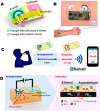Nanostructured wearable electrochemical and biosensor towards healthcare management: a review
- PMID: 37529357
- PMCID: PMC10387826
- DOI: 10.1039/d3ra03440b
Nanostructured wearable electrochemical and biosensor towards healthcare management: a review
Abstract
In recent years, there has been a rapid increase in demand for wearable sensors, particularly these tracking the surroundings, fitness, and health of people. Thus, selective detection in human body fluid is a demand for a smart lifestyle by quick monitoring of electrolytes, drugs, toxins, metabolites and biomolecules, proteins, and the immune system. In this review, these parameters along with the main features of the latest and mostly cited research work on nanostructured wearable electrochemical and biosensors are surveyed. This study aims to help researchers and engineers choose the most suitable selective and sensitive sensor. Wearable sensors have broad and effective sensing platforms, such as contact lenses, Google Glass, skin-patch, mouth gourds, smartwatches, underwear, wristbands, and others. For increasing sensor reliability, additional advancements in electrochemical and biosensor precision, stability in uncontrolled environments, and reproducible sample conveyance are necessary. In addition, the optimistic future of wearable electrochemical sensors in fields, such as remote and customized healthcare and well-being is discussed. Overall, wearable electrochemical and biosensing technologies hold great promise for improving personal healthcare and monitoring performance with the potential to have a significant impact on daily lives. These technologies enable real-time body sensing and the communication of comprehensive physiological information.
This journal is © The Royal Society of Chemistry.
Conflict of interest statement
There is no conflict of interest.
Figures










References
-
- Zhou Z. Chen K. Li X. Zhang S. Wu Y. Zhou Y. Meng K. Sun C. He Q. Fan W. Fan E. Sign-to-speech translation using machine-learning-assisted stretchable sensor arrays. Nat. Electron. 2020;3(9):571–578. doi: 10.1038/s41928-020-0428-6. - DOI
Publication types
LinkOut - more resources
Full Text Sources

